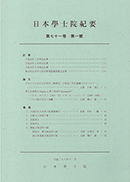All issues

Volume 73 (2019)
- Issue 3 Pages 139-
- Issue 2 Pages 57-
- Issue 1 Pages 1-
Predecessor
Volume 73, Issue 3
Displaying 1-1 of 1 articles from this issue
- |<
- <
- 1
- >
- >|
Article
-
Jun KUBOTA2019Volume 73Issue 3 Pages 139-150
Published: 2019
Released on J-STAGE: April 12, 2019
JOURNAL FREE ACCESSMy hypothesis that there is some connection between “ma” (space or pause),which has been considered important in classical Japanese literature and arts, and “yūgen” (ethereal beauty), an often-discussed aesthetic principle thereof. To prove this hypothesis, I examined what interests the authors have in “sukima”, a form of “ma”, how effectively they express it, and what intentions they have, using waka poems, karon (poetic treatises), and monogatari (narratives) as examples. The works I cited are as follows: waka poems from the Man’yōshū, waka poems composed by poets of the Heian period, Genji monogatari (The Tale of Genji), Mumyōshō (a poetic treatise by Kamo no Chōmei), Tsurezuregusa (Essays in Idleness, a collection of essays by Yoshida Kenkō), and Kosunoto (a jiuta song of the Edo period).
Furthermore, I introduced the criticisms made by Masaoka Shiki in his Utayomi ni atauru sho (Letters to a Tanka Poet), and the examples of usage of the word “yūgen” in Natsume Sōseki’s novel Kusamakura. Also, I argued that there is a connection between “yūgen” and “iki”, an aesthetic principle of early-modern Japanese literature and arts advocated by philosopher Kuki Shūzō in his book “Iki” no kōzō (The Structure of “Iki”), although the two notions appear to be quite distant from each other.View full abstractDownload PDF (1445K)
- |<
- <
- 1
- >
- >|